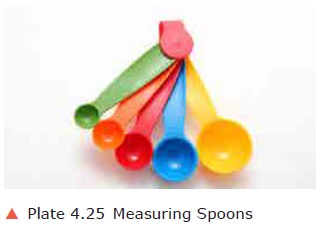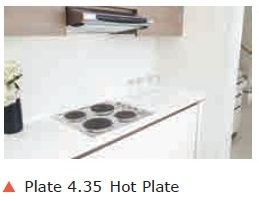Chapter: 11th Food Service Management : Chapter 4 : Food Service Equipment
Food Production Equipment
Production
Equipment
Production involves
pre-preparation and preparation.
1. Pre-preparation
Quantity food production depends
upon correct weights and measures. In order to obtain a standard product with a
standard yield, it is essential that food should be weighed and measured
accurately. A set of scales, measuring jugs, stand-ard measuring cups and
spoons can be used.
Learning how to measure ingredi-ents is essential for any preparation.
Being well versed with all measurements eases any preparation.
All foods have to be prepared before cooking and serving Eg:
washing, peeling, cutting, grinding. Each process requires good skills.
1. Tools for Measuring:
The three basic tools of
measurement includes:
Measuring spoons – Includes tea
spoon, table spoon


Dry measuring cups – They are
usually made up of glass, stainless steel, alumi-num or plastic and have even
rim.


Liquid measuring cups – These
cups have pour spout and handle which helps in add-ing the liquid ingredients
like milk, water and oil.
Measuring Tips
·
Do not
measure over mixing bowl
·
A pinch
is smaller than a dash (1/16 tsp)
·
Measuring
by weights rather than by volume is much more accurate.
2. Tools
for Stirring, Dipping and Turn-ing: It includes spoons,
ladles, turners,
spatulas and tongs.
3. Tools for
Blending: Mixer
is an important labour saving electrically operated piece of equipment for
multi-purpose use. For example, mixing pas-try, cakes, mashing potatoes,
beating egg, mincing or chopping meat and vegetable, beating butter, whipping
cream and dough–wet dry. Blenders are
used to grate, chop or puree. The food cutter may be purchased with added
feature for slicing, grinding and cubing.
4. Food
Slicers and Peelers: When por-tion control is stressed the slicer will
determine the amount to be sliced. Peelers use to peel potatoes and other root
vegetables with minimum waste by action on a revolving abrasive disc.
5. Miscellaneous
Tools: Strainers, cut-ting board, rolling pins and knives are included. Knives
like paring, utility, carving, slicing, butcher knives and cleavers are used.
2. Preparation
The equipment needed for
preparation and cooking large quantities of food are given below:
1. Boilers
Many types are available in
different met-als and size. They may be heated by gas, electricity or steam
from the main supply. The advantage of boilers is that they do not allow the
food to burn.

Types of Boilers
![]() There are three types of
boilers namely
There are three types of
boilers namely
a.
Pressure
boiler – Boils rice
b.
Automatic
boiler – Boils food at inter-vals
c.
Bulk
boiler – Large quantities of food boiled at a given time

2. Steamers
They are sealed compartments
where steam is allowed to come in direct contact with the food for cooking.
Steaming ovens that work from a main steam supply needs little maintenance.


This type of equip-ment is usually fitted with a gauge which registers steam pressure, also an overflow valve which gives a warning
whistle if the pressure reaches danger point. These should be periodically
checked to ensure that they are working correctly. A constant supply of water
should be maintained in the steam generating tank. Steamer trays inside the
steamer should be cleaned and rinsed. They are ideal for vegetable cook-ery
because they retain the colour and texture without undue shrinkage.
3. Range
A range is (also called a stove
top) a large appliance where surface burners are used to cook food. It is
favourable for opera-tion that features to cook the menu items ordered by the
customer. It gives intense heat which can be regulated and large quantities of
food can be cooked. A vari-ety of range designs are available includ-ing solid
tops, open tops and grilled tops. The pots and pans used should be heavy
bottomed. After each cooking cycle the equipment should be turned off.

4. Oven
An oven is an enclosed cabinet
where food is cooked by dry and hot air. The entire electric oven is fitted
with an on-off switch which operates the oven. Once the oven is switched on and
the temperature is set it maintains the desired temperature. The lower
com-partment is loaded with food which is put on evenly spaced shelves and
baked.

5. Hot Plate
It is used as a tawa for the
preparation of chappatis, dosas and pan cakes.


6. Tilting Pan
It is a deep edged pan and the
food is braised, stewed or cooked. When the food is cooked, tilt the pan and
remove the food.
Related Topics